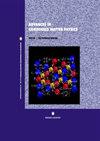Structural, Electronic, Dynamic, and Optical Properties of 2D Monolayer Tungsten Telluride (2H-WTe2) under Small Biaxial Strain Using Density Functional Theory (DFT and DFT + U)
IF 1.8
4区 物理与天体物理
Q3 PHYSICS, CONDENSED MATTER
引用次数: 0
Abstract
The structural, electronic, vibrational, and optical properties of 2D- 2H-WTe2 monolayer are investigated using density functional theory with respect to a plane wave ultrasoft pseudopotentials (PW-USPPs) in a generalized gradient approximation (GGA) and with the Hubbard potential (GGA + U). The equilibrium state properties such as lattice parameters, unit cell volume, bulk modulus, and its derivative are determined. The band gap values of monolayer 2H-WTe2 are investigated for unstrained, 2% biaxial compression, and biaxial tensile stress using GGA, respectively. The obtained band gap values of 2H-WTe2 with respect to GGA are 1.043, 1.1487, and 0.9439 eV for unstrained, biaxial compression, and tensile strain, respectively. Moreover, the band gap values determined using Hubbard correction (GGA + U) are 1.1089 eV (unstrained), 1.2332 eV (2% biaxial compression), and 0.9945 eV (2% biaxial tensile stress), respectively. The band gap value obtained using Hubbard correction predicts the experimental value more precisely. The projected density of state shows W (3d) orbital is more dominant both in the valence band maximum and conduction band minimum. Moreover, a small amount of tensile or compressive strain is used to tune the band gap of the monolayer without affecting its direct band gap nature. In addition to this, the phonon dispersion and optical properties are discussed for tensile strain, unstrained, and compressive strain, respectively.基于密度泛函理论(DFT和DFT + U)的小双轴应变下二维单层碲化钨(2H-WTe2)的结构、电子、动态和光学性质
利用密度泛函理论研究了二维- 2H-WTe2单层膜的结构、电子、振动和光学性质,并结合广义梯度近似(GGA)和哈伯德势(GGA + U)研究了平面波超软赝势(PW-USPPs)。平衡态的性质,如晶格参数,单位胞体积,体积模量,及其导数被确定。利用GGA分别研究了单层2H-WTe2在未应变、2%双轴压缩和双轴拉伸应力下的带隙值。在非应变、双轴压缩和拉伸应变下,得到的2H-WTe2相对于GGA的带隙值分别为1.043、1.1487和0.9439 eV。此外,采用Hubbard校正(GGA + U)确定的带隙值分别为1.1089 eV(未应变)、1.2332 eV(2%双轴压缩)和0.9945 eV(2%双轴拉伸应力)。利用Hubbard校正得到的带隙值更准确地预测了实验值。投影态密度表明,W (3d)轨道在价带最大值和导带最小值上均占主导地位。此外,使用少量的拉伸或压缩应变来调整单层的带隙,而不影响其直接带隙性质。除此之外,还分别讨论了拉伸应变、非应变和压缩应变下声子色散和光学性质。
本文章由计算机程序翻译,如有差异,请以英文原文为准。
求助全文
约1分钟内获得全文
求助全文
来源期刊

Advances in Condensed Matter Physics
PHYSICS, CONDENSED MATTER-
CiteScore
2.30
自引率
0.00%
发文量
33
审稿时长
6-12 weeks
期刊介绍:
Advances in Condensed Matter Physics publishes articles on the experimental and theoretical study of the physics of materials in solid, liquid, amorphous, and exotic states. Papers consider the quantum, classical, and statistical mechanics of materials; their structure, dynamics, and phase transitions; and their magnetic, electronic, thermal, and optical properties.
Submission of original research, and focused review articles, is welcomed from researchers from across the entire condensed matter physics community.
 求助内容:
求助内容: 应助结果提醒方式:
应助结果提醒方式:


